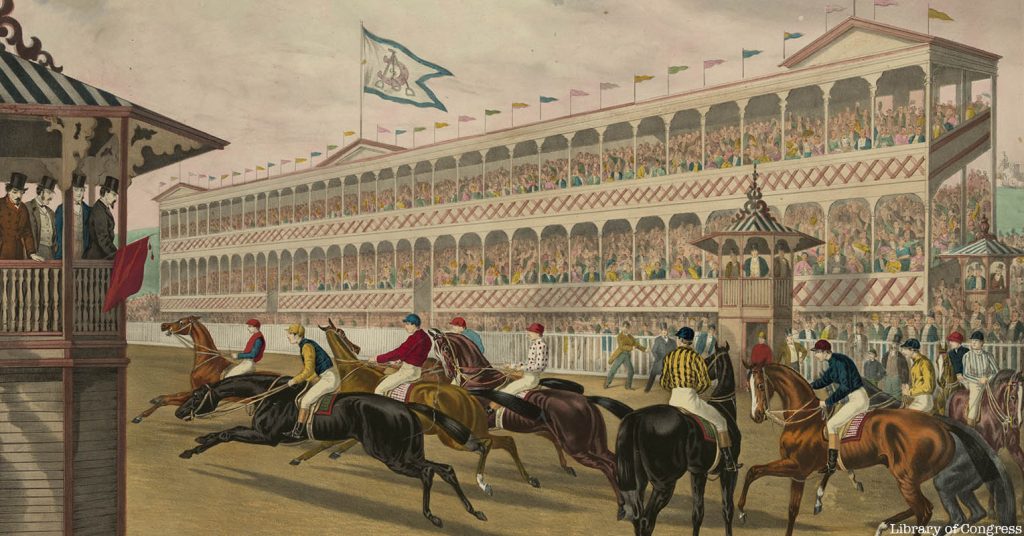
by Kate Richards
It was April 1866 in New York City. Three men gathered in Leonard Jerome’s Wall Street office to discuss sport and horses, specifically the need for a nearby track for New York City organized racing. They were relaxed with each other even though each man possessed very different characteristics, yet they were friendly competitors, in one romantic case, rivals. They probably smoked cigars brought back by Belmont on one of his diplomatic trips to Cuba where he was advocating a purchase of the island for the US from Spain. Recently elected National Chairman of the Democratic Party, Belmont sr, was a consummate politician and sometime counsel to President Lincoln regarding appeasing southern states by offering cotton growers an offshore location to harness the laborers and placate the abolitionists. “Cotton was needed for the growth of manufacturing…secession was not” advised Belmont sr… For August Belmont, everything and anything represented business and in that, profitable opportunity.
“C-c-c-cotton, you say. Let’s add in these f-f-fine Cuban c-cigars” the always amiable Willie Travers probably grinned.
William R. Travers was a lawyer by profession and traveled between Saratoga, his home base, Newport and Bermuda on his yacht, “Fanny”, so named as a jib against Jerome and Belmont who shared a mistress. Shrewd in his investments, Travers was quite wealthy yet was more recognized for his self-deprecating storytelling, usually involving himself and his pronounced stutter. In Traver’s 1889 New York Times obituary, it was noted that he was the most popular man in New York City, President of the Athletic Club, Saratoga Racing President and a member of 20 social clubs. In an age where popularity was attributed to how many clubs to which one belonged, Travers won the garland. (NYTimes obituary 1889) Literally every man on Wall Street had a Travers story to share. One such anecdote involved a banker named Henry Clews who took pride in his bootstrap success. Travers, overhearing one such Clew’s boast, began to stare at Clew’s balding head.
Clews, noticing Travers’ stare, asked “Well, what’s the matter Traver’s?”
“H-Henry”, Travers inquired “D-d-didn’t you say that you were a s-s-self-made m-man?”
Crews answered, “Why certainly, I made myself!”
Travers came back quickly, “Then, w-w-hen you were about it, w-w-why didn’t y-y-ou p-put more hair on the t-t-top of your head.”
Another Henry Clew’s story about his witty friend Willie Travers involved Clews soliciting Travers’ creativity concerning a costume for the upcoming Vanderbilt ball. Travers responded,
“Clews, w-why d-don’t you s-sugar coat your h-head and go as a p-pill.”
(The Saratogian) (NYTimes 1889,Library of Congress)
Racing history, and if one thinks about it, our modern-day sport, is an abundant treasure trove of colorful personalities, horse pedigrees and ideas that have origins in ambition, egos, accidents of fate and dreamscapes. The shape of things to come, anchored in the recounting of the history of the Belmont Stakes must be told with a full-flavored richness and through understanding the personalities of these men…Belmont, Travers and Jerome.
Fierce. Jerome’s grandson, Sir Winston Churchill, recalled him as being ‘fierce’ in his approach to business and sport. (WinstonChurchill.org)
With his drooping moustache and loquacious personality, Leonard Jerome was a connoisseur of women, fine horses, and racing yachts, a very handsome ‘rascal’, so much so that his very proper wife, Clara enjoyed social seasons abroad with the three Jerome daughters, young Clara, Leonie and the infamous Jennie, later Lady Randolph Churchill. The Jerome sisters were a part of the American heiress wave that descended on the London marital market teeming with impoverished aristocrats. The writer, Edith Wharton wrote about them in her last novel, “The Buccaneers”. Mrs. Wharton also made prototypical use of the Belmont-Jerome males before in her previous novel, “The Age of Innocence” modeling her character Julius Beaufort on the publicly known personality traits of the wily Belmont and the snake-charmer, Jerome. Wharton described Beaufort.
“The circumstances of his life and a certain native shrewdness made him better worth talking too than many men, morally and socially his bettors…how should anyone not feel the difference and be attracted to it” Wharton (1920)
New York historical papers would have it that these men would compete against each other on the track, on the ocean or for the charms of a socialite named Mrs. Fanny Ronalds. Belmont and Jerome were Butch and Sundance, with their Huckleberry friend, Travers, that were prototypes for Wharton’s male figures full of hubris yet equally prepared to advance visionary opportunities in business. It was to them, that the Knickerbocker males flocked for tips, loans and commercial advancement. Mark Twain coined the phrase “gilded’ to describe this emerging business class, yet he wrote the words cynically. America, particularly Wall Street, seemingly held an endless supply of risky opportunities and it was the speculators that panned for gold. It was these men, particularly Belmont, who, for a time, conjured the gilt and harnessed its glow to anything and everything that involved winning.
While not as flamboyant as Jerome or as verbally memorable as Travers, the elder Belmont possessed a well-tuned ‘Master of all he saw’ approach to business, politics and to sport. Born Aaron Schonberg in Prussia, later annexed into Germany, he was the son of a well-connected, land-owning Jewish family. His father was able to place Aaron, now renamed August, into a coveted clerkship with the Rothschild banking concern in Germany where the young man quickly rose from an internship to a representative status representing the Rothschilds in Italy and then, to Cuba and finally to New York. The Rothschild US representative bank failed in 1837, and the newly arrived August Belmont sr. filled that void with his own company. As he rose in banking, the multi-lingual, now-named Belmont began his climb through the Knickerbocker hardened social circles of the city, met and married Caroline Perry, the daughter of the US Naval Commodore Matthew Perry. He then became an Episcopalian. So skillful in mining future opportunities, Belmont rendered himself indispensable to the city fathers, the social lions, the diplomatic corps and to the Democratic Party, initially supporting Stephen Douglas yet later a trusted advisor to Abraham Lincoln. It was racing that bound him to Travers and Jerome as well as his, Belmont’s, admiration for the club-like atmosphere and wagering potential modeled after the English racing scene.
He purchased a farm in Kentucky for breeding purposes but with Civil War conscription of bloodstock, realized that upstate New York, promoted by his friend, the Saratoga-based William R. Travers, offered a safer potential as an attractive racing and breeding location. The next move in his master plan was to create a regional racing emporium in Westchester County. It was with this purpose that the three men, all influencers, met to carve a monied Stakes race and with it, the race’s first location, Jerome Park. Jerome and Travers had been successful in developing the Saratoga racing meet with Congressman ‘Old Smoke’ Morrissey and J.R. Hunter. Starting in 1863 with a four-day meet, the inaugural Travers Stakes was won by a colt named Kentucky owned, in part, by Jerome and Travers. Later, at the turn of the century, Belmont’s son, also named August, would lead the financing and development of Belmont Park in Elmont, NY, opening in the spring of 1905. The race that became known as the Belmont Stakes preceded the Belmont track. The impetus of the Wall Street meeting in spring 1866 was to take the Saratoga model and create a racing venue outside of New York City. Earlier in that year, Jerome had purchased the Bronx mansion and surrounding 230 acres from James Bathgate with the financial backing of Belmont Senior. A purposeful acquisition, as these three men aimed to create a socially acceptable arena for sport where women would be fashionably comfortable and leave their men to gamble and deals. Money begets money, they thought. Their goal was to introduce European parimutuel betting, handicapping in the form of live ‘touts’ and clubhouse memberships for men. Towards encouraging feminine attendance, each clubhouse member was allowed to escort two women for free with any additions to be charged one dollar. The dress codes encouraged the ladies and the gents to dress in their finest, something that created satellite businesses eager to ply their racewear. As all three-Belmont, Jerome and Travers were breeders, the Jerome racetrack was also the first to showcase two-year old racing. It was also during this meeting that the three discussed the need for a more organized approach to stud and mare registration (classicnyhistory.com).
In true American entrepreneurial fashion, first there was an idea and then a meeting of three unique and powerful visionaries, all committed to the ideas and successful prototypes, and conniving enough, rich enough, to give life to these concepts. The rascal, the wit and the Master of all he saw. Jerome, Travers and Belmont. And so, it was in April 1866 in Leonard Jerome’s cigar smoke-filled Wall Street office that the goals of organized City racing, an English style venue, parimutuel betting and later, the American Jockey Club formed a blueprint for what became known as the Belmont Stakes.
Photo: Library of Congress



